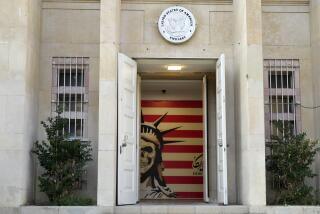Q&A: Hossein Khosrojerdi’s first U.S. solo show opens at Tara Gallery
Tehran-born Hossein Khosrojerdi has enjoyed a more than 30-year career as a prominent visual artist. He represented Iran during its debut at the 2003 Venice Biennale (Iran’s first time participating in the contemporary art event after the Islamic Revolution) and two years prior his digital painting, “Gaze,” won the grand prize at the international Sharjah Biennial.
But the Iranian expatriate, who’s currently living in self-imposed exile in London, has never had a solo show in the U.S. -- until now.
On Saturday night, Tara Gallery in Santa Monica, the nonprofit gallery arm of the Los Angeles-based American Foundation for Contemporary Iranian Art, will debut “Redefining Home,” a mix of digital works and abstract paintings by Khosrojerdi.
The artist won’t be in attendance at the opening, but he spoke to Culture Monster about his journey from Iran to the UK as well as the work that came out of it.
When did you leave Iran and why?
I left Iran in 2009 because my environment was too closed and I wanted to enter a more open society. I had an active role in the green movement and I knew I would be in trouble. Plus the fact that before Ahmadinejad’s first term, there was more freedom for the growth of visual arts, but under his regime, it was extremely closed.
How did shifting your surroundings from Iran to the UK affect your work, making it, as you say, “more fluid and less genre-specific”?
When you live in a closed environment, your view is limited and when you expand your view in a more open environment, you can think more open. It was as if I passed through a civilization tunnel and this made me aware of a larger world; I learned a more global language.
Can you talk about your transformation after the Iranian Revolution – and how ghosts and mummies factor into your work as a result? It’s not the typical, scary depiction.
At first, I was an “Artist of Revolution,” supporting it fully. Then I started to find out that my questions are not answered by religion or by the political environment. I started depicting this lone person who struggles to find answers for everyday life’s issues (the mummy). Mummies are non-gender, non-religious beings with no specific nationality or race. They represent human beings. Without religion, gender or nationality, it is a symbol of a lone person.
What is your series on buildings saying about the human yearning for shelter, security and a place to call home?
Darkness and blackness are symbols of the unknown -- as if entering a dark room. I feel I am in a dark room and have not found the light switch yet, [haven’t yet] learned what is my life about here.
What’s the work in this show like -- and why, in these paintings, is negative space important to you?
The work is basically representative of three series, the digital paintings, buildings and abstract works. In my abstract paintings, positive spaces depict the main topic, but I think negative spaces are as important. These paintings are based on many lines that are cut and then become round and changed in direction. To me, it is like people who because of their differences of opinion tend to be separated. These lines, though they go in different directions, they ultimately can present a beautiful image.
Is the work in your show, despite coming out of political turmoil, uplifting?
I am not working from a negative base. I accept these as the realities of our time and don’t look at them negatively. I believe these times will pass and Iranians will earn the democracy they deserve. There is pain and struggle; but democracy does not come to any nation freely.
Twitter: @debvankin
More to Read
The biggest entertainment stories
Get our big stories about Hollywood, film, television, music, arts, culture and more right in your inbox as soon as they publish.
You may occasionally receive promotional content from the Los Angeles Times.







